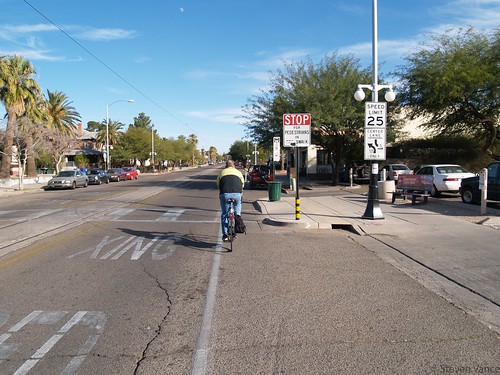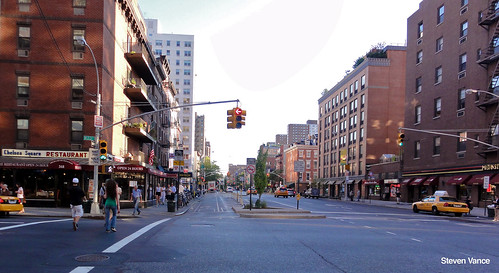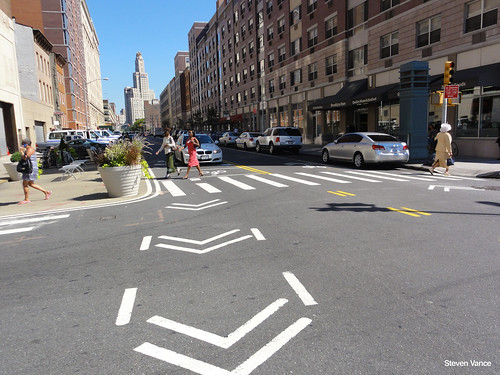Shouldn't we be trying new roadway designs?
Even a woman with a baby stroller won't convince drivers to obey the law and stop for pedestrians at this notoriously dangerous crosswalk. Broadway and Balmoral. Photo by Kevin Zolkiewicz.
Mayor Bloomberg of New York City today announced that 2011 has been the city's year with the fewest traffic fatalities since 1910.
Wow - that's awesome.
They had 237 traffic fatalities in 2011, and 270 in 2010. In 2010, Chicago had 315 traffic fatalities. They had 3 child pedestrian fatalities in 2011. In 2010, Chicago had 25 fatalities for people 18 and younger.
From their press release:
Traffic calming projects, street redesigns, and safety upgrades installed by the Department of Transportation during the past decade have resulted in improved safety throughout the five boroughs. In the last four years alone, the department has implemented safety improvement projects along 78 corridors and at 72 intersections. In 2011, the department made safety upgrades to 60 miles of streets, including more than 20 miles of street redesigns and implemented the city’s first Neighborhood Slow Zone in the Bronx, creating the first 20 miles per hour speed limit. Additionally, the department introduced new electronic speed boards in all five boroughs that display the speed of passing motorists and expects to bring additional Neighborhood Slow Zones online.
The City has built a single "home zone" (which didn't come with speed limit changes), bumpouts scattered around town, and experimented with colored pavement markings at three intersections, and is working to put Lawrence Avenue on a diet, there's no coordinated effort like a Vision Zero campaign or PlaNYC 2030. The Pedestrian Safety Campaign's strategy roadmap hasn't been revealed, and we're waiting for the Chicago Fast Forward Agenda in spring 2012. Nothing to link the Bike 2015 Plan with the Chicago Climate Action Plan or the Pedestrian Plan. And little leadership in City Council to deal with these things comprehensively (a new law banning cellphones while biking but not increasing bike lane parking enforcement isn't helpful).
There's CMAP's GOTO2040 plan, but have any Alderman heard of or read it?
/endrant?
Well, that's the introduction to my article on Grid Chicago: Safer roadway designs: How Danes make right turns
Shouldn't Chicago be trying out new stuff, too?
Tags:
Replies to This Discussion
-
Permalink Reply by Anne Alt on January 1, 2012 at 5:14am
-
There are a bunch of locations where I'd like to see curb bumpouts at crosswalks on busy streets like Broadway, 95th St., etc. We have too many locations where crossing major streets is like a real-life version of Frogger.
Coordinating the Bike 2015 Plan with Chicago Climate Action Plan and the Pedestrian Plan would make a lot of sense, so that measures developed in one don't conflict with with the other plans. Ideas for one of the plans could reach maximum effectiveness and give more bang for the buck if they're developed in such a way that they could help the big picture goals of all three plans.
A new law banning cellphones while biking but not increasing bike lane parking enforcement isn't helpful.
The amount of sheer waste and stupidity due to lack of communication and coordination between city agencies and programs could almost be laughable in better times. In this period of fiscal uncertainty, it's more important than ever to have better coordination between programs.
-
Permalink Reply by Far'arned Retrogrumpalunkus #63 on January 1, 2012 at 2:19pm
-
I feel curb bump-outs make bicycling more dangerous.
Whenever the road narrows it squeezes bikes and cars into a conflict zone. Cars are pretty much oblivious of us in the first place but when we need to move over into the faster car lanes because the curb bumps out into the small area at the edges we seem to be banished to it is the bicyclist who becomes the one put into the danger zone.
I'm not at all in favor of bumpouts unless there is also clear and marked bicycling lane/safe-zone for us to ride with some personal space instead of BUMPED over into the bumper-car-kill zone.
-
Permalink Reply by Anne Alt on January 1, 2012 at 2:44pm
-
I don't see 95th St. ever having bike lanes (except for the eastern end where they already exist). It's a major truck route. Many aspects of the street would need to be changed for bike lanes to be feasible there.
Do you remember the experiment with bumpouts on Clark St. in Andersonville several years ago? They did a test period where they marked proposed outlines for bumpouts on the pavement, and emphasized the outlines with flex posts. In that experimental configuration, the bumpouts were too large and would have pushed cyclists into conflict with cars if they'd been real instead of outlines. I ended up riding between the flex posts to stay clear of traffic and saw a lot of other cyclists doing the same thing.
Many of us asked for smaller bumpouts, taking up no more lane width than a parked car - the width that was ultimately used for the real bumpouts. Those have been successful in increasing pedestrian visibility, reducing crossing distance and making crossing easier for pedestrians, not increasing the hazard for cyclists.
I would not favor bumpouts that are wider than a parked car for exactly the reason you describe.
-
Permalink Reply by Steven Vance on January 1, 2012 at 2:55pm
-
I don't remember a bumpout outline with flexposts test.
I think this bumpout in Tucson is the smaller one you describe, Anne.
For larger bumpouts, you could make a cut through for cycling, essentially an island. Like this in New York City.
New York City has been making "soft" bumpouts and islands, by painting the ground and adding large planters. See the two photos below:
Click on any photo to see more information about it, and see where it is on a map.
-
Permalink Reply by Anne Alt on January 2, 2012 at 2:43am
-
Good examples, Steve.
I don't remember the exact year when they did that bumpout test period in Andersonville, but it was probably around 2003 or 2004. Do any Rogers Park or Edgewater people remember that? I know that some of you were bike commuting through there, same as I was.
Steven Vance said:I don't remember a bumpout outline with flexposts test.
I think this bumpout in Tucson is the smaller one you describe, Anne.
For larger bumpouts, you could make a cut through for cycling, essentially an island. Like this in New York City.
New York City has been making "soft" bumpouts and islands, by painting the ground and adding large planters. See the two photos below:
Click on any photo to see more information about it, and see where it is on a map.
-
Permalink Reply by Steven Vance on January 4, 2012 at 7:05pm
-
So I'm going to write a new series called "Design Errors", or something, and point out all the ways our road designs lead to confusion.
Here's a video (from the same Dutch pair that brought you the intersection transformation animation video) that describes an intersection in the Netherlands (with the highest crash rate, 14 injuries a year when 14,000 people ride through it daily) and that "the intersection does not tell people how to use it".
What do you think of people learning how to use the street based on how it was designed? Think of products that are very popular (like the iPod). Why did something that cost 3x as much as its competitor ($400 when it came out) become the more sought after item? For one, it had a logical and intuitive music browser. You didn't need instructions, it told you how to use it.
-
Permalink Reply by Meg Matthews on January 5, 2012 at 7:09am
-
I hate bumpouts. There are a bunch on MLK going south. Guess where giant potholes tend to open up? (Although at this point, there are giant potholes all over the bike lane between 29th and 33rd, thanks to heavy bus traffic I think.) The soft bumpouts might be better...
-
Permalink Reply by Anne Alt on January 5, 2012 at 7:32am
-
+1
Steven Vance said:So I'm going to write a new series called "Design Errors", or something, and point out all the ways our road designs lead to confusion.
Here's a video (from the same Dutch pair that brought you the intersection transformation animation video) that describes an intersection in the Netherlands (with the highest crash rate, 14 injuries a year when 14,000 people ride through it daily) and that "the intersection does not tell people how to use it".
What do you think of people learning how to use the street based on how it was designed? Think of products that are very popular (like the iPod). Why did something that cost 3x as much as its competitor ($400 when it came out) become the more sought after item? For one, it had a logical and intuitive music browser. You didn't need instructions, it told you how to use it.
-
Permalink Reply by Anne Alt on January 5, 2012 at 7:39am
-
I have a similar complaint about recent ADA curb ramp installations in my neighborhood. When they're added in places where the street isn't being repaved at the same time, the contractors are often doing a very poor job of how the new asphalt meets the old, effectively pre-installing potholes.
I've talked to Gabe Klein about this problem. If they can't do a better job of bonding new asphalt with old, whether it's at bumpouts or curb installations, perhaps the use of a flexible crack sealer along the entire joint could protect it against premature pothole formation.
Can anyone with knowledge about paving speak to this issue and whether they think this could be an effective solution, or if they have other ideas? Pre-installation of potholes at pieces of infrastructure that are supposed to improve accessibility is really lame.
Meg Matthews said:I hate bumpouts. There are a bunch on MLK going south. Guess where giant potholes tend to open up? (Although at this point, there are giant potholes all over the bike lane between 29th and 33rd, thanks to heavy bus traffic I think.) The soft bumpouts might be better...
-
Permalink Reply by Lanterne Rouge on January 5, 2012 at 8:13am
-
Anne - where did they try the bumpouts in Andersonville? As a new(er) resident of the neighborhood, I'm curious.
-
Permalink Reply by Mark on January 5, 2012 at 9:20am
-
The bumpout "test" was along Clark Street between Foster and Bryn Mawr in 2000 or so. The idea was to bumpout all of the curbs, leaving only legal parking spaces. This included eliminating bus stops, so the buses would stop in the driving lane. It also eliminated all of the end-of block illegal parking spaces that people use to pull over and wait while someone quickly runs into a store to pick something up.
So instead of going through with the actual construction of the bumpouts, flexible barriers were installed, similar to along Kinzie Street. The test period was supposed to be for 6 months. The barriers were very confusing and drivers hated them - including me. Many of the barriers got run over, and after about 1 month, the whole idea was scrapped.
-
Permalink Reply by Steven Vance on January 5, 2012 at 9:32am
-
It seems failed from the start. Why not build a real bumpout to test, or do what New York City did and paint the ground and use planters to keep drivers out.
Thanks for the info.
Mark said:The bumpout "test" was along Clark Street between Foster and Bryn Mawr in 2000 or so. The idea was to bumpout all of the curbs, leaving only legal parking spaces. This included eliminating bus stops, so the buses would stop in the driving lane. It also eliminated all of the end-of block illegal parking spaces that people use to pull over and wait while someone quickly runs into a store to pick something up.
So instead of going through with the actual construction of the bumpouts, flexible barriers were installed, similar to along Kinzie Street. The test period was supposed to be for 6 months. The barriers were very confusing and drivers hated them - including me. Many of the barriers got run over, and after about 1 month, the whole idea was scrapped.
Groups
-
Chicagoland Beer Explora…
203 members
-
Wednesday Night for Mort…
1 member
-
Great Lakes Ultra Cycling
270 members
-
Major Taylor Internation…
1 member
-
Critical Mass discussion
261 members




